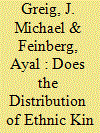| Srl | Item |
| 1 |
ID:
183958


|
|
|
|
|
| Summary/Abstract |
The literature on ethnic kin-groups primarily focuses on their role in perpetuating conflict. Less attention has been devoted to how ethnic kin-groups might encourage mediation in disputes affecting their kin in other nations. We argue that transborder kin-groups’ collective concern for the welfare of their fellow members in other states can motivate interstate mediation efforts. Utilizing the Ethnic Power Relations and the Issue Correlates of War datasets, we examine how transborder kin-group connections shape the likelihood of mediation, as well as who provides it. Our findings suggest that the deeper the network of transborder kin-group connections among target states of territorial disputes, the more likely mediation is to occur. Alternatively, challenger transborder kin-group connections reduce the likelihood of mediation. While transborder kin-group connections help explain the likelihood of mediation, mediation is often not provided by the connected third-party state. Instead, these connections promote mediation from international organizations, particularly regional organizations.
|
|
|
|
|
|
|
|
|
|
|
|
|
|
|
|
| 2 |
ID:
174469


|
|
|
|
|
| Summary/Abstract |
Over the last two decades alone, the United States has suffered well over ten thousand religion-motivated hate crimes. While racism and religion-motivated prejudice have received considerable attention following the “Unite the Right” rally in Charlottesville that resulted in deadly violence, there is little systematic scholarship evaluating where and when incidents targeting ethnoreligious minorities by non-state actors are likely to occur. Utilizing the FBI’s reported anti-Semitic hate crime data from 2001–2014, my main theoretical and empirical exercise is to determine which factors best explain where and when American ethnoreligious groups are likely to be targeted. I propose that there are four essential mechanisms necessary to explain variation in minority targeting: “opportunity” (target group concentration), “distinguishability” (target group visibility), “stimuli” (events increasing target group salience) and “organization” (hate group quantity). My models show that variables falling within each of these theoretical concepts significantly explain variation in anti-Semitic incidents in the United States. Of particular importance for scholars and practitioners alike, Israeli military operations and the number of active hate groups within a state play a major role in explaining anti-Semitic incident variation.
|
|
|
|
|
|
|
|
|
|
|
|
|
|
|
|
| 3 |
ID:
184513


|
|
|
|
|
| Summary/Abstract |
The 2016 Trump campaign held more than 300 rallies. Our research examines whether these rallies and Trump’s rhetoric served as opportunities for the spread of hate. We measured the number of reported white-supremacist propaganda, anti-Semitic incidents, and extremist behaviors that occurred both leading up to and directly following these campaign events. We contend that Trump’s rhetoric and rallies increased the perceived threat facing white Americans, heightening their white identity, all while justifying violence and extralegal methods to address their grievances and thereby increasing reported bias incidents. We find that counties that hosted a Trump rally experienced an increase in hate-motivated events. We systematically show that Trump political rallies were associated with a limited size but significant rise in the likelihood of reported hate and bias incidents.
|
|
|
|
|
|
|
|
|
|
|
|
|
|
|
|